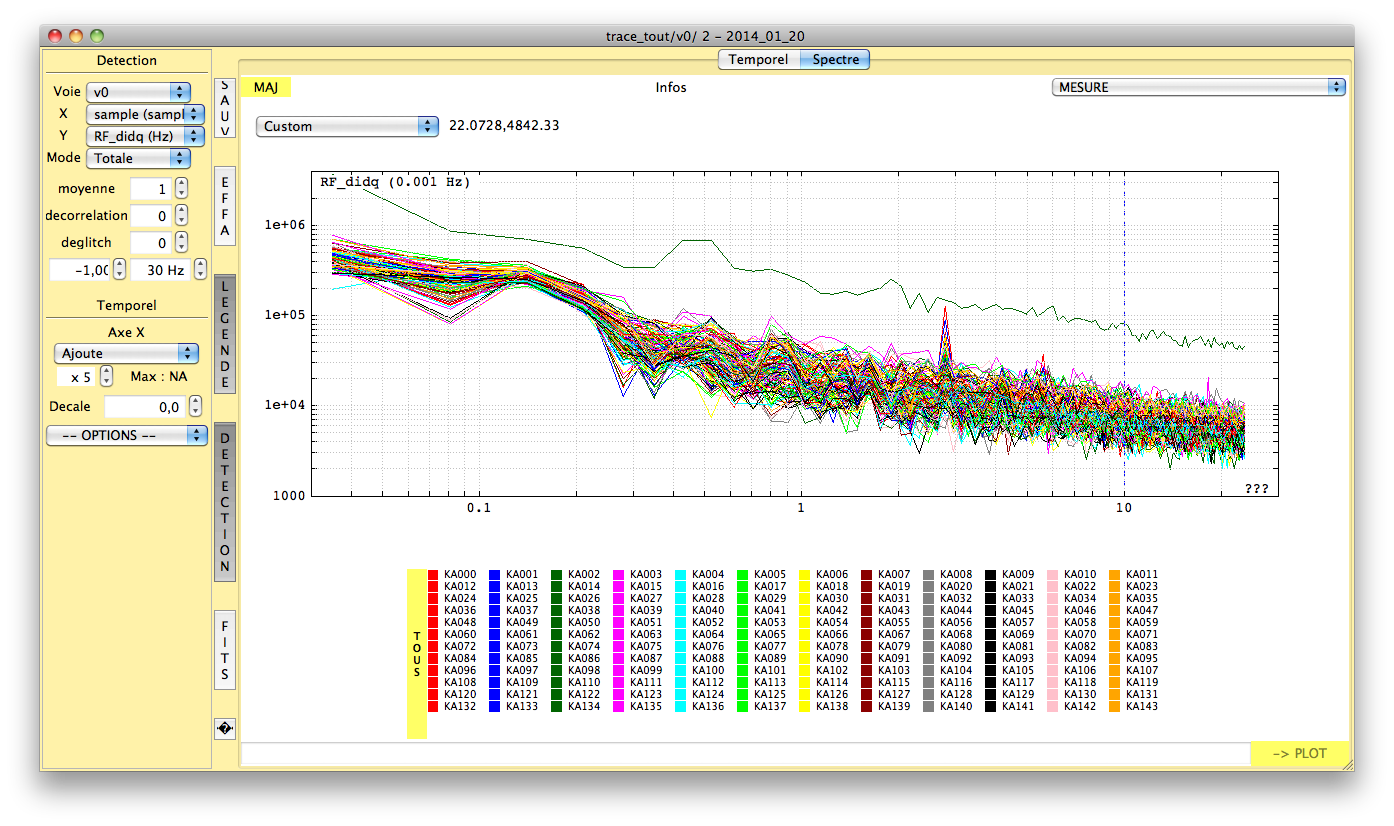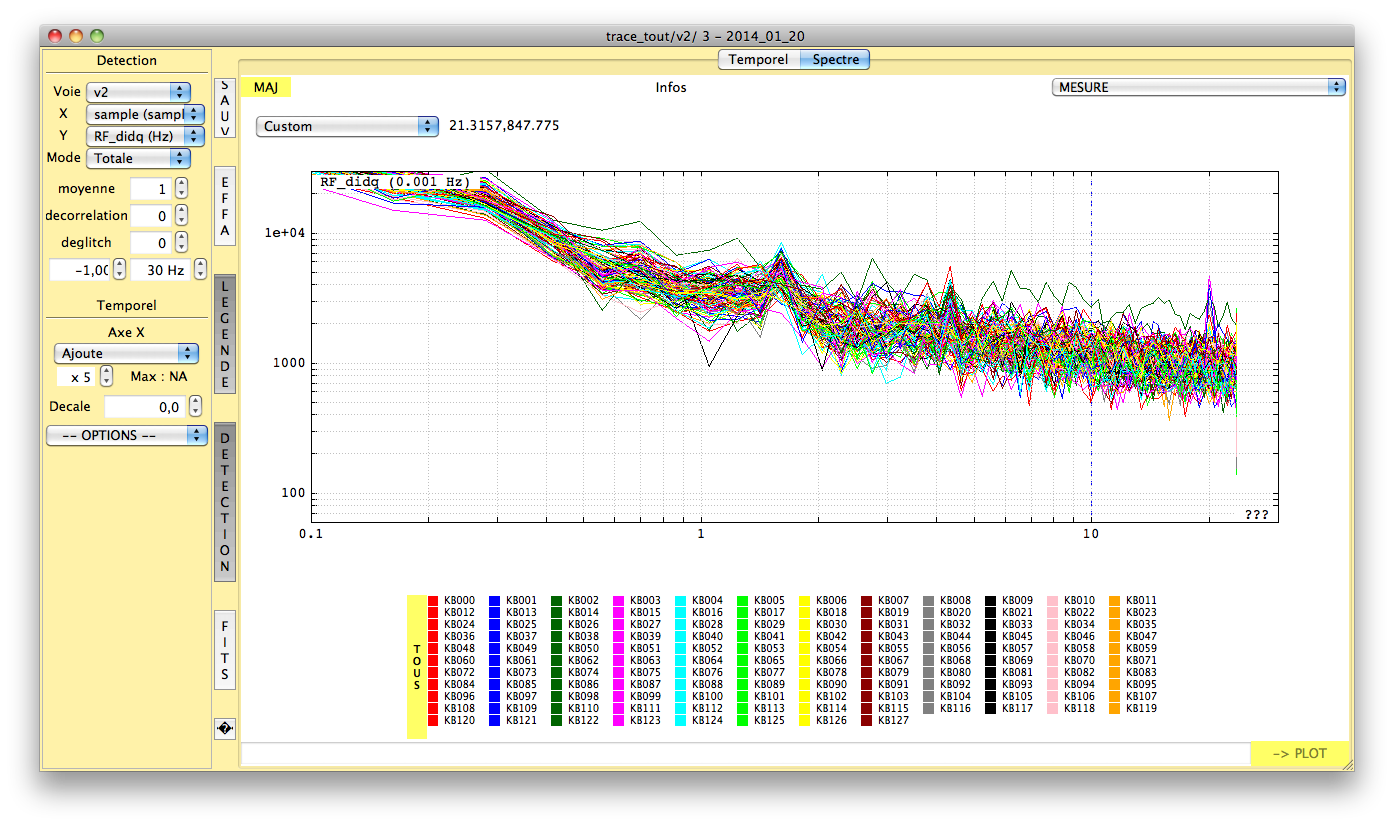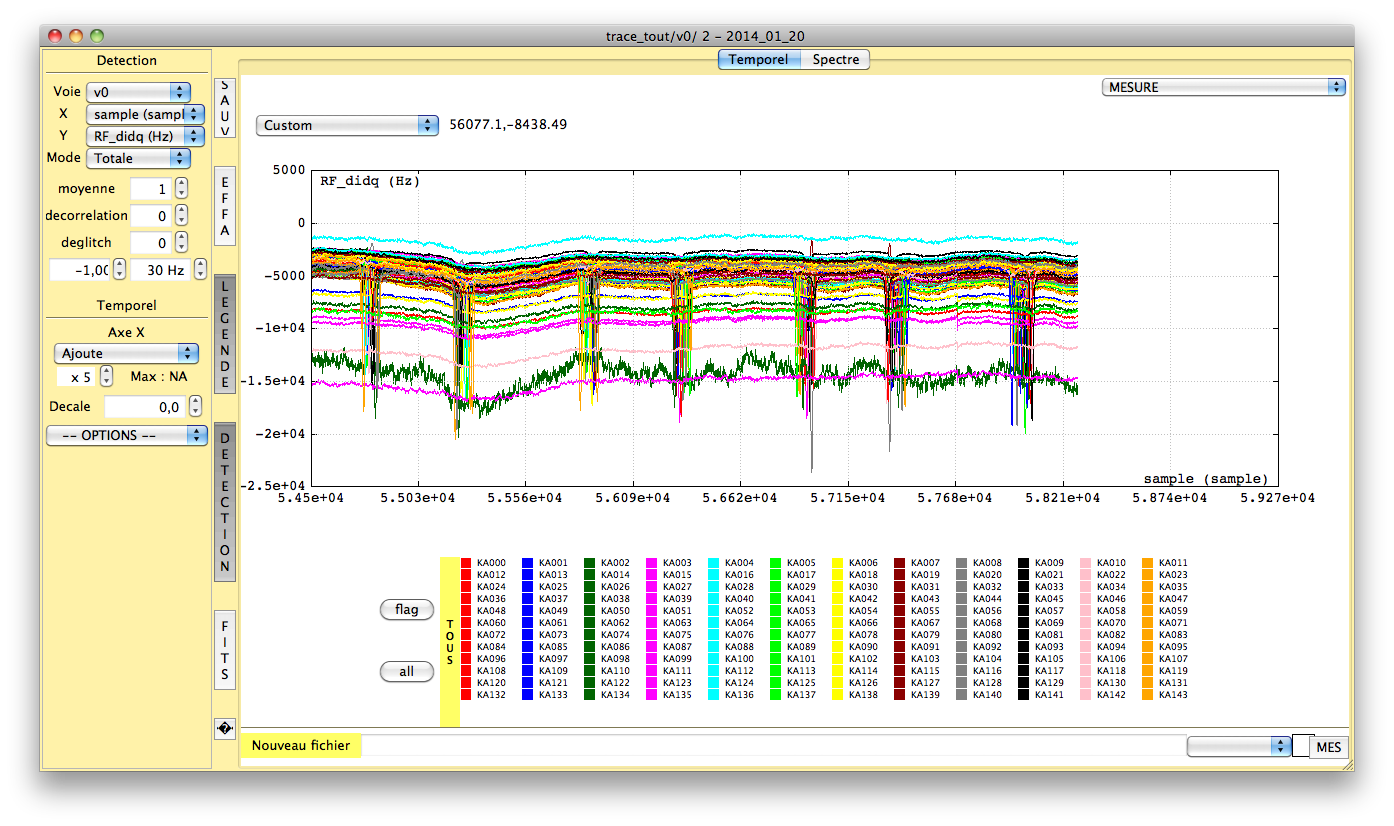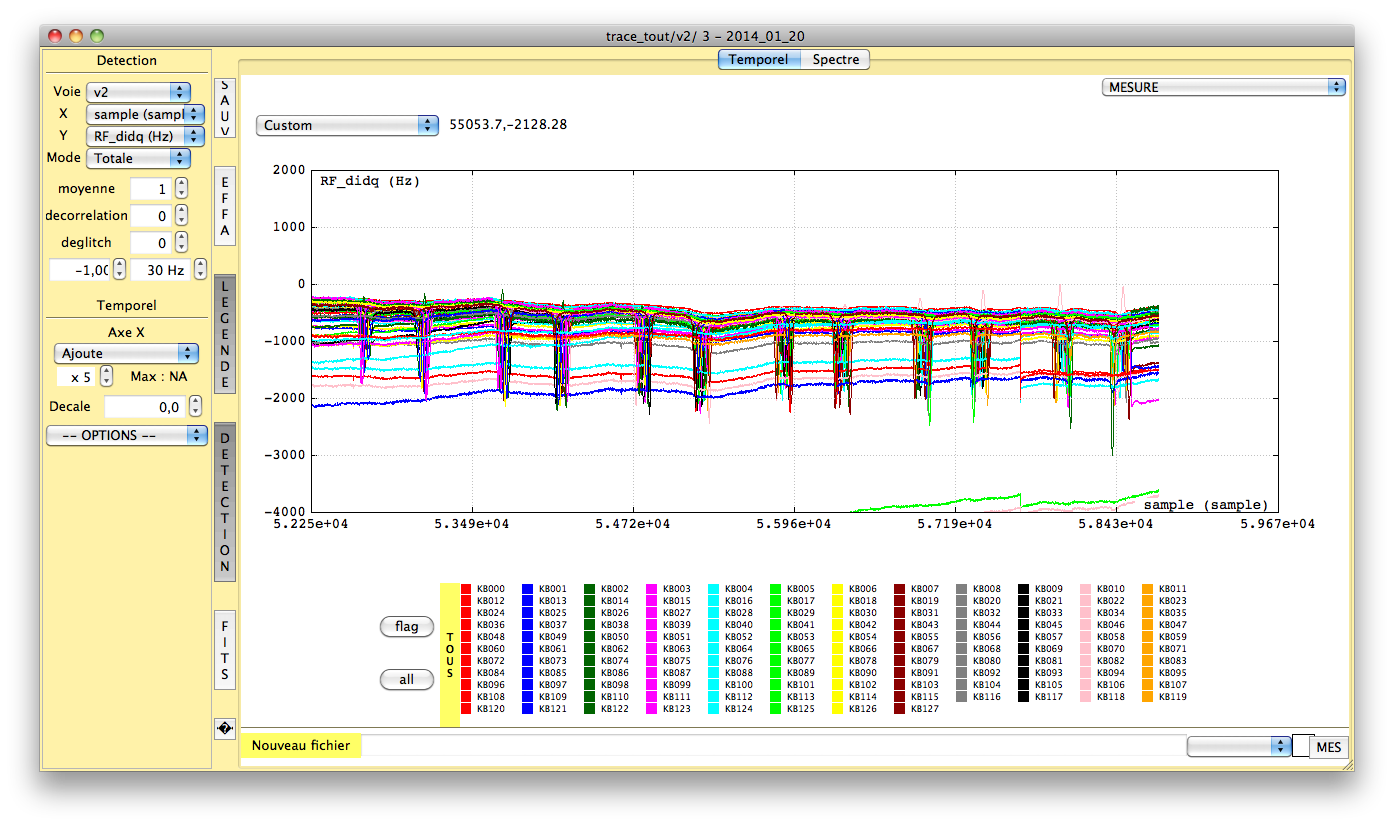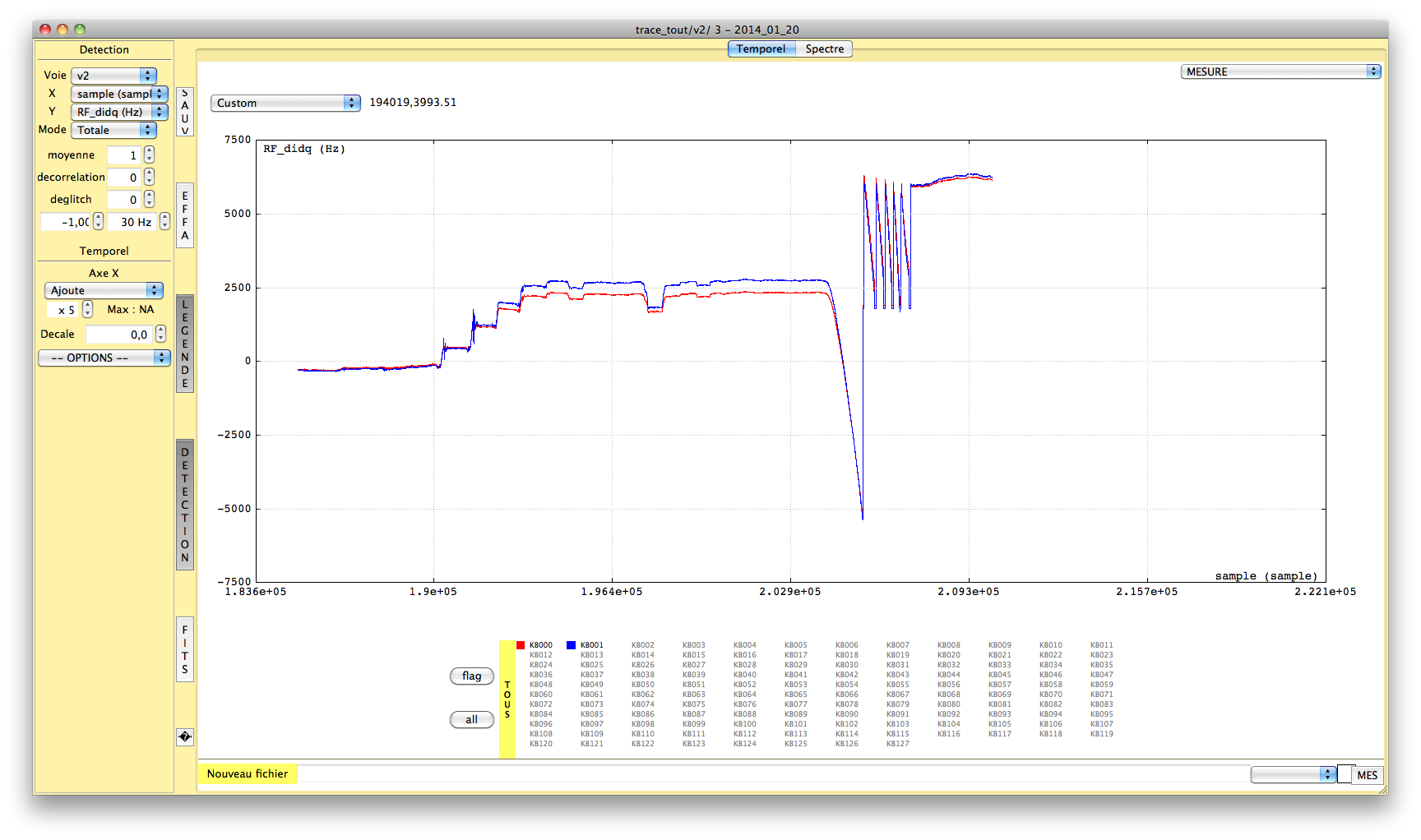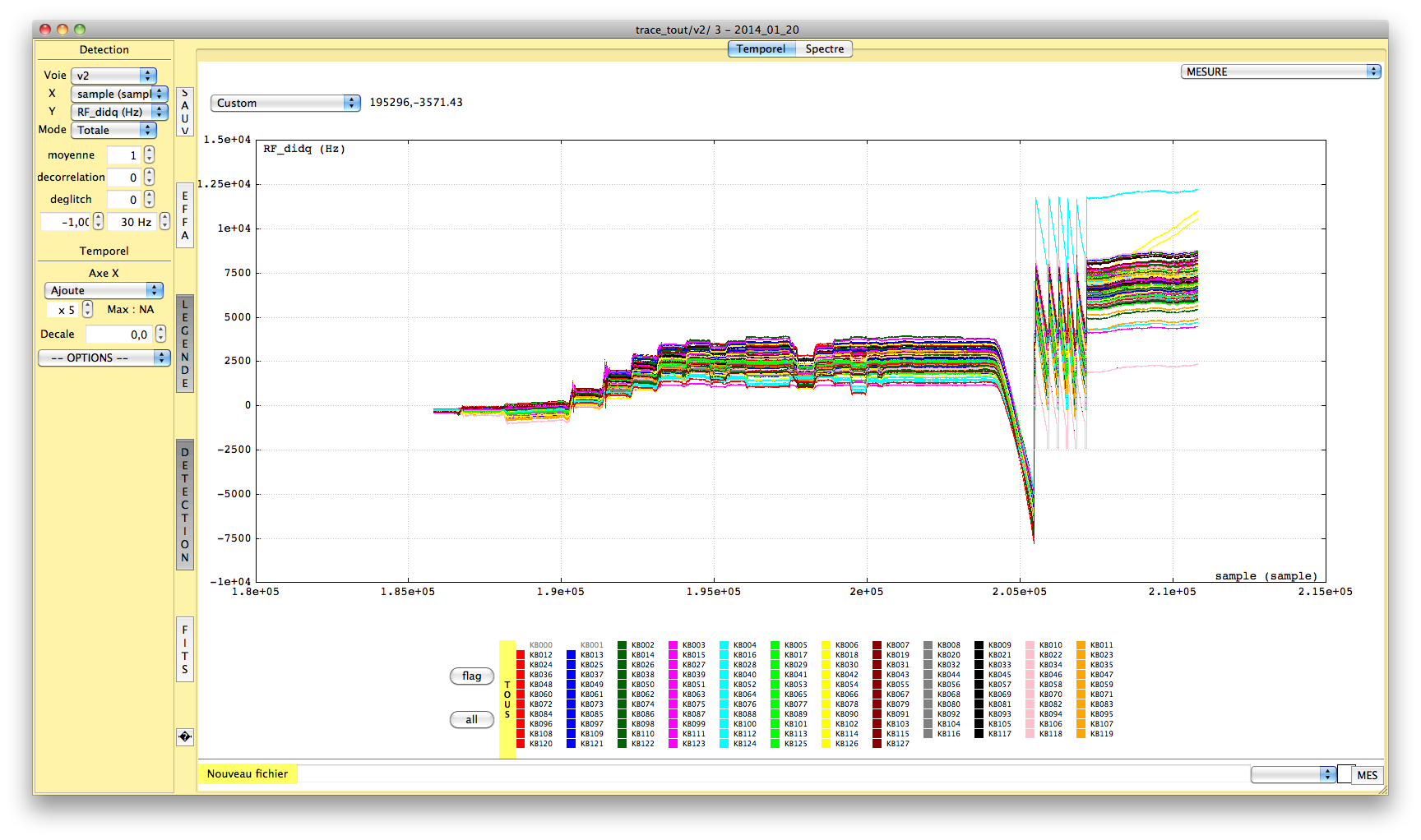|
Size: 3611
Comment:
|
Size: 14185
Comment:
|
| Deletions are marked like this. | Additions are marked like this. |
| Line 2: | Line 2: |
<<TableOfContents(2)>> |
|
| Line 103: | Line 106: |
'''12h30m:''' Window on cryostat REMOVED. Modulator (without polarizer and plate) mounted and centered approximately in front of the cryostat. Question is leave it or not for total power observations ? '''15h (Alessandro): OPTICAL RESPONSE ESTIMATION On the 2mm array, from window closed to 300K (window open, looking at the cabin), the frequency shift is -105kHz. VERY SIMILAR (was around -100kHz) TO WHAT WE HAD OBSERVED FOR RUN 6 (see daily report in run6). In Grenoble this array exhibited a shift of about +180kHz between 80K and 300K, equivalent to 0.8kHz/K. So, it seems that the windows is only equivalent to 300-100/0.8=175K. - On the 1mm array, from window closed to 300K (window open, looking at the cabin), the frequency shift is around -320kHz !! In the last run 6 we had only -150KHz. Remember we had at that time one additional filter 9cm-1 that's now removed. So the signal is twice that run6. But the noise should be higher due to the fact that the resonances are shallower now. Should be very sensitive to the tau. In very good sky I expect the noise on RF_dIdQ to go down fast. PAY ATTENTION, THESE NUMBERS ARE ASSUMING THAT THE KID DID NOT DRIFT TOO MUCH BETWEEN 12h30 when we opened the window and 15h when we re-tuned. It's a reasonable assumption. See later for the verification. TO CONFIRM, we TRIED WITH LN2. The shifts from window to LN2 are +410kHz at 1mm and +130KHz in this case, confirming that the values we have said. So, the window is around 180K and the response of the arrays are roughly 0.8KHz/K for the 2mm and 2.5KHz/K for the 1mm array.''' {{attachment:optical_tests_preliminary.png||width=1200}} In the picture above (y-axis: delta_f in KHz of the resonances; x-axis: time) we see the three situations tested today. Azure: reference (param) with the window ON; Red: array 1mm; Blue: array 2mm. Start and end: no window, looking at the 300K in the cabin. Step in the middle: LN2 in front of the pupil (a bit farther than the pupil wrt the cryostat). '''17h:''' Alain and Andrea working in the cabin .... the sync signal is back. Ground problem on the modulator .. '''18h:''' Snowing, strong wind .... no observations of course. Forecast for tomorrow is even worse. ''Remarks from SL: *It would be very bad that the window is at 180K, hopefully what you mean is that the 300K of the cabin seen through the window appears as a 180K black body. The window itself should have a T,,RJ,, ~ 70K. Besides I guess that what you mean when you say "window close" or "open" or "ON" etc. is actually "(metallic) shutter (in front) of the window close" or "open" or "ON" etc. '''! CHICO, CLARO QUE SI !''' *To answer the question about the polariser modulator: we will of course remove it for the total power observations, since we want a clear characterization of the instrument, so we need to make the reference without the modulator. And in order to quantify the effect it has, the days we have polarized observations scheduled (see [[ListOfAstroTarget2014N7#Commissioning_requirements_and_observations_plan|the program]]) we will do total power observations with the modulator that are identical to observations done the previous day when the modulator was not there, and only after that we will proceed with the polarized observations. *Otherwise, except for the weather it seem that so far everything is good. Nice job guys. Good luck for the week-end and see you on Tuesday.'' == January 19th 2014 == '''11h:''' Calibration of the HWP modulator done. See elog post for details. '''12h:''' New script PaKo for skydip up and down on nikaw-13 account (skydip_up.pako and skydip_updown.pako). To simplify the procedure we execute only one subscan per elevation instead of two. Test OK in configuration set doSubmit no. Need to test with the acquisition. '''15h:''' Made parameter file under LN2 on the pupil (see "detectors information run 7" to see the file). Measured the power going into the cryostat. Using the DAC values found in Grenoble '''(DAC 20,23,20,25,32 at 1mm; DAC 20,23,20,27,35 at 2mm; niveau 5 on both)''' we have '''-54dBm at cryostat input for the 1mm and -55dBm per tone on the 2mm'''. A bit weak at 1mm but to be taken into account that I have measured at the end of the long 2m flexible cables. Means that 2dB difference in attenuation is present between 1.3GHz and 2GHz. == January 20th 2014 == '''10h:''' Wonderful weather. We observe tonight at 18h. Cryostat now looking at 300K. No window on it. Modulator in place (without HWP and polariser of course). Compared to the param we have made on LN2 at the pupil we are at -740kHz on the 1mm and -240kHz at 2mm. So OK compared to what we said the day before yesterday. 410+320=730kHz; 105+130=235kHz. '''10h30:''' Temperature regulation on 150mK. '''17h00: Attention, always go up to the cabin with the operator for the M3 switch. Not so obvious for the operators since there are three positions. Risk to be put on GISMO position.''' '''17h15: NIKA run7 starts!!!''' Compared to the 'param' file we made with LN2 at the pupil, the KID (both 1mm and 2mm at the same value, and that's strange) are roughly 60kHz COLDER when seeing the (very good) Sky. So the very good Sky is colder than LN2 but not THAT much. According to what we had measured with the window yesterday and before we could estimate the temperature of the Sky in about 15-50K (depending if we consider OK the 2mm or the 1mm respectively). The order of magnitude is correct. Made many scans. In particular, in a very good sky (tau < 0.1), we performed OTF_geom allowing to measure the signal on Uranus. See the day to day report as usual. Also, we measured the noise when off-source. || {{attachment:noise1mm.png||width=900}} || {{attachment:noise2mm.png||width=900}} || '' '''Figure.''' Noise measured on the sky for the 1mm (left) and 2mm (right). Power on KID still to be optimised, hopefully will reduce the dispersion.'' || {{attachment:uranus1mm.png||width=900}} || {{attachment:uranus2mm.png||width=900}} || '' '''Figure.''' Signal on Uranus measured on the sky for the 1mm (left) and 2mm (right). Power on KID still to be optimised, hopefully will reduce the dispersion. Taken arbitrarily focus -2.4 with no check.'' Signal on Uranus was exactly as expected around 10kHz at 1mm and 1-2kHz at 2mm. Noise seems (assuming good decorrelation) 3-5Hz/sqrt(Hz) at 1mm and 0.9Hz/sqrt(Hz) at 2mm. So considering that Uranus is 42/16Jy in Flux we have on the time traces something like 21mJy/sqrt(Hz) and 14mJy/sqrt(Hz) '''per pixel''' at respectively 1mm and 2mm. EVERYTHING TO BE CONFIRMED, ASSUMING PERFECT DECORRELATION ETC. SO THESE FIGURES ARE OVER-OPTIMISTIC FOR REAL MAPS, JUST TAKE THEM AS TIME-TRACE SENSITIVITIES. '''19h30: RADIOMETRIC ALIGNMENT''' By turning the micrometric screws by 1.25 turns and 0.5 turns respectively on x and y (to adjust the orientation of M5) we could shave still a bit in background and make sure we have centered M1 on the pupil. || {{attachment:aligntwo.png||width=900}} || {{attachment:alignall.png||width=900}} || '' '''Figure.''' Radiometric alignment (left: trace tout on a couple of 2mm pixels; right: something for all the pixels). By properly aligning we gained 7.5kHz on the 1mm and 2.5kHz on the 2mm.'' Considering the transformation coefficients calculated using all the window/LN2/300K tests we conclude that we have reduced the background by 3K, or roughly 10% compared to the Sky temperature estimated few lines above (17h). '''19h50: a nice skydip''' {{attachment:skydip.png||width=900}} '' '''Figure.''' A skydip seen in the new 'hysto' tracing the dFtone. Red: 1mm; Blue:2mm. Confirms the factor 3 in response between the two arrays.'' ''' FOR THE ENTIRE 20/01/2014 SESSION NO ANTENNA DATA DUE TO SW PROBLEMS ''' == January 21st 2014 == NP SL AR at the telescope. After discussing with Santiago: we are afraid that the minimal background is actually not the best radio alignment, indeed if the NIKA pupil is misaligned such that it sees the sky next to M2 it's possible that the background is lower than seeing only M2 (the other hypothesis we had was that the pupil misalignment sees the edge of M1 diffracting the 300K from the ground, so increase the background on the array). Too late to re-check alignment with laser and absorbers in the cabin. Only way to know now is to look at a source (Uranus) with M5 on the "best laser (alignment) position", then look at the source with M5 on the "minimal background" position and compare the beams: the stronger and narrower beam is the one with the best illumination of the telescope pupil (hoping this effect will be dominating the effect of sky noise). Zemax simulation shows that the tilt done yesterday moves the beams position by a bit more than one detector size, and that the misalignment of the cryostat pupil with the primary may cause a significant loss of illumination (~20% on the thumb estimation from the footprint diagram, assuming laser alignment was perfect) that would create broader and fainter beams. '''Observing session from 17h30 to 0h00''' .30min tests with data acquisition upgrade and tuning. .~2h many pointing (crosses and Lissajous) on Uranus: to understand and correct Nasmyth offsets at the 2 positions of M5, and then compare the scans. Despite a badly degrading sky we come to the conclusion that yesterday's background minimization was probably not the thing to do, since on the "best laser" position we have brighter and narrower beams than on the "minimal background" position. Alignment to be checked again with Santiago tomorrow. Note: we didn't do focus during this time because the comparison between the 2 positions of M5 is not dependent on focus, al long as there's a roughly correct beam (which was the case with ~18" at 2mm). .Skydips while analysing and understanding pointing scans at the 2 positions of M5 .At the best position for M5 and Nasmyth offset to get sources at the centre of the arrays, do focus to optimise beam => focus scans not very conclusive (sky not good, tau ~1 !). Re-use yesterday's best focus position and do several otfgeometry... tau much better on the last otfgeom. .Uranus too low, too late for pointing session, and besides we need to continue understanding the pipeline results on pointing scans. .Many pointings on 3c84. Try to understand results (e.g. change of rotation centre due to Nasmyth offset). == January 22nd 2014 == |
Contents
January 14th 2014
Andrea Catalano come to the 30m to turn on the NIKA cryostat and checking the cool down remotely controlled from Grenoble (Alain Benoit, Alessandro Monfardini and Martino Calvo).
STATUS OF THE INSTRUMENT
9h30: Reboot of the PC NIKA and change the VNC forwarding on the router.
10h: Pumped the trap (J5=46mbar). Pumped the dilution circuit (until Jpi=3e-2mbar).
11h: Pressions stables. ZERO OF J1 IS -25mbar!!!
12h: Connected the leak detector. Residual pressure in the cryostat 6.6mbar.
12h15m: Optical alignment of the cryostat started.
12h30m: Impedance 18mbar/min at 3bar. It is maybe less w.r.t. the last run cryo (not clear from the old files). WE CONTINUE.
13h: Leak test: OK, in the 1e-9 range.Pumped ev18 for 15 minutes. It was well empty in any case. REMEMBER NOT TO TOUCH ev18 ANYMORE.
13h: Optical alignment OK.
14h: GREEN LIGHT for switching on the Pulse Tube. Mixture circulated for two hours at 3bar.
14h30m: Pulse Tube on with 900mbar.
15h30m: Lowering to 870mbar. Keep the same during the night.
23h10m: T4K=160K. Tstill=125K. Lowering the flux at 630mbar for the night.
January 15th 2014
Cooling down still going on.
STATUS OF THE INSTRUMENT
07h00m: T4K=25K. Tstill=30K. Lowering the flux at 340mbar.
09h15m: Close ev5.
10h30m: Coax connected, mppsync connected, computers on (archeops 8-9-10) in the control room
11h00m: Condensation starts.
16h00m: 100mK !!!.
17h45m: Stop Compressor
18h30m: Stop leak detecotr.
18h30m: Nitrogen refill.
18h30m: HWP modulator connected.
January 16th 2014
STATUS OF THE INSTRUMENT
08h30m: T_BM=96mK pretty stable (DeltaT_BM about 1mK over 12h), T_still=682mK (DeltaT_still about 5mK over 1h), T_4K=5.23K (DeltaT_4K about 20mK over 1h), J4 stable at 580mbar.
21h30m: T_BM=95.8mK pretty stable (DeltaT_BM about 1mK over 12h), T_still=685mK (DeltaT_still about 7mK over 1h), T_4K=5.2K (DeltaT_4K about 20mK over 1h), J4 stable at 550mbar.
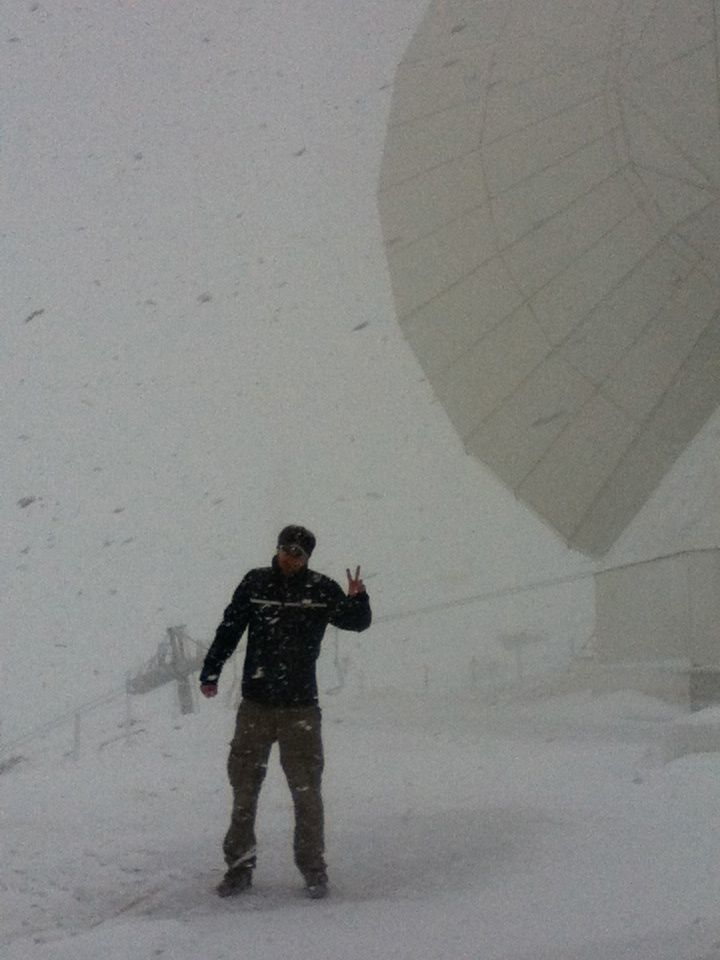
Alone waiting for the rest of the NIKA gang....
January 17th 2014
Nicolas joins the Telescope at 10am. Preparing tomorrow observations (pako, pipeline, etc...)
STATUS OF THE INSTRUMENT
08h30m: T_BM=95mK pretty stable (DeltaT_BM about 1mK over 12h), T_still=655mK (DeltaT_still about 6mK over 1h), T_4K=4.91K (DeltaT_4K about 80mK over 1h), J4 stable at 537mbar.
11h30m: All the scripts pako and the NIKA catalogue copied in the new account nikaw-13 (to be used for the poll).
14h30m: Refill Nitrogen in the trap done.
14h30m: Problems to connect to the mppsync. Maybe memory card burnt?
20h20m: T_BM=94.7mK pretty stable (DeltaT_BM about 0.5mK over 12h), T_still=650mK (DeltaT_still about 3mK over 1h), T_4K=4.88K (DeltaT_4K about 10mK over 1h), J4 stable at 530mbar.
January 18th 2014
Alain and Alessandro join the telescope skiing in the blizzard!
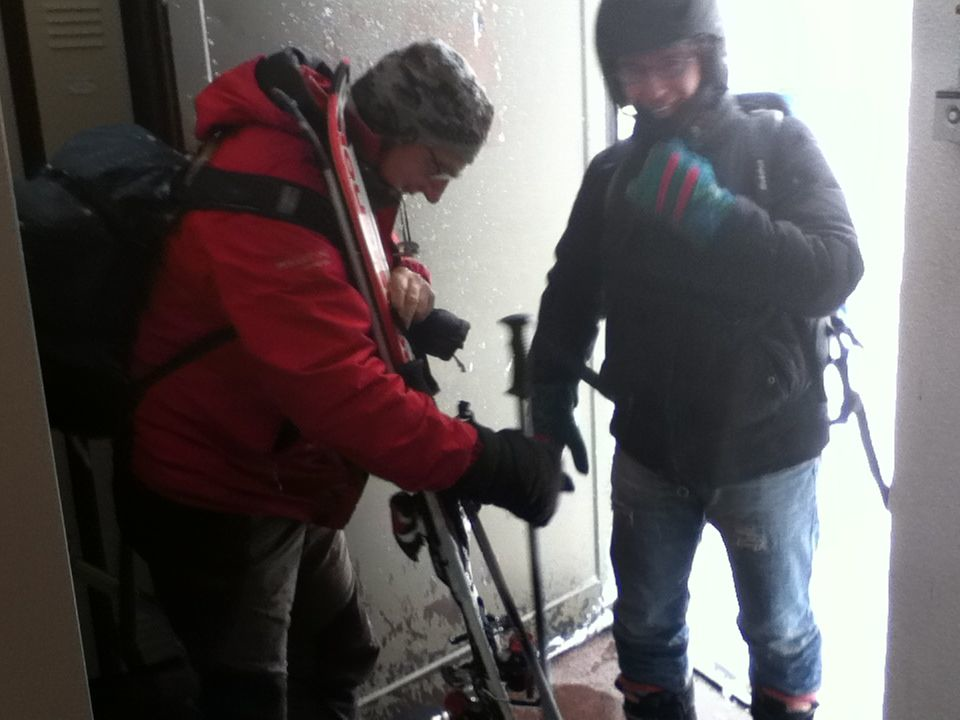
We do all this only for science.....
STATUS OF THE INSTRUMENT
07h50m: T_BM=94.5mK pretty stable (DeltaT_BM about 0.6mK over 12h), T_still=655mK (DeltaT_still about 5mK over 1h), T_4K=4.89K (DeltaT_4K about 8mK over 1h), J4 stable at 535mbar.
09h30m: mppsync connection problems repaired by changing the memory card.
12h30m: Window on cryostat REMOVED. Modulator (without polarizer and plate) mounted and centered approximately in front of the cryostat. Question is leave it or not for total power observations ?
15h (Alessandro): OPTICAL RESPONSE ESTIMATION On the 2mm array, from window closed to 300K (window open, looking at the cabin), the frequency shift is -105kHz. VERY SIMILAR (was around -100kHz) TO WHAT WE HAD OBSERVED FOR RUN 6 (see daily report in run6). In Grenoble this array exhibited a shift of about +180kHz between 80K and 300K, equivalent to 0.8kHz/K. So, it seems that the windows is only equivalent to 300-100/0.8=175K. - On the 1mm array, from window closed to 300K (window open, looking at the cabin), the frequency shift is around -320kHz !! In the last run 6 we had only -150KHz. Remember we had at that time one additional filter 9cm-1 that's now removed. So the signal is twice that run6. But the noise should be higher due to the fact that the resonances are shallower now. Should be very sensitive to the tau. In very good sky I expect the noise on RF_dIdQ to go down fast. PAY ATTENTION, THESE NUMBERS ARE ASSUMING THAT THE KID DID NOT DRIFT TOO MUCH BETWEEN 12h30 when we opened the window and 15h when we re-tuned. It's a reasonable assumption. See later for the verification. TO CONFIRM, we TRIED WITH LN2. The shifts from window to LN2 are +410kHz at 1mm and +130KHz in this case, confirming that the values we have said. So, the window is around 180K and the response of the arrays are roughly 0.8KHz/K for the 2mm and 2.5KHz/K for the 1mm array.

In the picture above (y-axis: delta_f in KHz of the resonances; x-axis: time) we see the three situations tested today. Azure: reference (param) with the window ON; Red: array 1mm; Blue: array 2mm. Start and end: no window, looking at the 300K in the cabin. Step in the middle: LN2 in front of the pupil (a bit farther than the pupil wrt the cryostat).
17h: Alain and Andrea working in the cabin .... the sync signal is back. Ground problem on the modulator ..
18h: Snowing, strong wind .... no observations of course. Forecast for tomorrow is even worse.
Remarks from SL: It would be very bad that the window is at 180K, hopefully what you mean is that the 300K of the cabin seen through the window appears as a 180K black body. The window itself should have a TRJ ~ 70K. Besides I guess that what you mean when you say "window close" or "open" or "ON" etc. is actually "(metallic) shutter (in front) of the window close" or "open" or "ON" etc. ! CHICO, CLARO QUE SI ! To answer the question about the polariser modulator: we will of course remove it for the total power observations, since we want a clear characterization of the instrument, so we need to make the reference without the modulator. And in order to quantify the effect it has, the days we have polarized observations scheduled (see the program) we will do total power observations with the modulator that are identical to observations done the previous day when the modulator was not there, and only after that we will proceed with the polarized observations. Otherwise, except for the weather it seem that so far everything is good. Nice job guys. Good luck for the week-end and see you on Tuesday.
January 19th 2014
11h: Calibration of the HWP modulator done. See elog post for details.
12h: New script PaKo for skydip up and down on nikaw-13 account (skydip_up.pako and skydip_updown.pako). To simplify the procedure we execute only one subscan per elevation instead of two. Test OK in configuration set doSubmit no. Need to test with the acquisition.
15h: Made parameter file under LN2 on the pupil (see "detectors information run 7" to see the file). Measured the power going into the cryostat. Using the DAC values found in Grenoble (DAC 20,23,20,25,32 at 1mm; DAC 20,23,20,27,35 at 2mm; niveau 5 on both) we have -54dBm at cryostat input for the 1mm and -55dBm per tone on the 2mm. A bit weak at 1mm but to be taken into account that I have measured at the end of the long 2m flexible cables. Means that 2dB difference in attenuation is present between 1.3GHz and 2GHz.
January 20th 2014
10h: Wonderful weather. We observe tonight at 18h. Cryostat now looking at 300K. No window on it. Modulator in place (without HWP and polariser of course). Compared to the param we have made on LN2 at the pupil we are at -740kHz on the 1mm and -240kHz at 2mm. So OK compared to what we said the day before yesterday. 410+320=730kHz; 105+130=235kHz.
10h30: Temperature regulation on 150mK.
17h00: Attention, always go up to the cabin with the operator for the M3 switch. Not so obvious for the operators since there are three positions. Risk to be put on GISMO position.
17h15: NIKA run7 starts!!!
Compared to the 'param' file we made with LN2 at the pupil, the KID (both 1mm and 2mm at the same value, and that's strange) are roughly 60kHz COLDER when seeing the (very good) Sky. So the very good Sky is colder than LN2 but not THAT much. According to what we had measured with the window yesterday and before we could estimate the temperature of the Sky in about 15-50K (depending if we consider OK the 2mm or the 1mm respectively). The order of magnitude is correct.
Made many scans. In particular, in a very good sky (tau < 0.1), we performed OTF_geom allowing to measure the signal on Uranus. See the day to day report as usual. Also, we measured the noise when off-source.
|
|
Figure. Noise measured on the sky for the 1mm (left) and 2mm (right). Power on KID still to be optimised, hopefully will reduce the dispersion.
|
|
Figure. Signal on Uranus measured on the sky for the 1mm (left) and 2mm (right). Power on KID still to be optimised, hopefully will reduce the dispersion. Taken arbitrarily focus -2.4 with no check.
Signal on Uranus was exactly as expected around 10kHz at 1mm and 1-2kHz at 2mm. Noise seems (assuming good decorrelation) 3-5Hz/sqrt(Hz) at 1mm and 0.9Hz/sqrt(Hz) at 2mm. So considering that Uranus is 42/16Jy in Flux we have on the time traces something like 21mJy/sqrt(Hz) and 14mJy/sqrt(Hz) per pixel at respectively 1mm and 2mm. EVERYTHING TO BE CONFIRMED, ASSUMING PERFECT DECORRELATION ETC. SO THESE FIGURES ARE OVER-OPTIMISTIC FOR REAL MAPS, JUST TAKE THEM AS TIME-TRACE SENSITIVITIES.
19h30: RADIOMETRIC ALIGNMENT
By turning the micrometric screws by 1.25 turns and 0.5 turns respectively on x and y (to adjust the orientation of M5) we could shave still a bit in background and make sure we have centered M1 on the pupil.
|
|
Figure. Radiometric alignment (left: trace tout on a couple of 2mm pixels; right: something for all the pixels). By properly aligning we gained 7.5kHz on the 1mm and 2.5kHz on the 2mm.
Considering the transformation coefficients calculated using all the window/LN2/300K tests we conclude that we have reduced the background by 3K, or roughly 10% compared to the Sky temperature estimated few lines above (17h).
19h50: a nice skydip
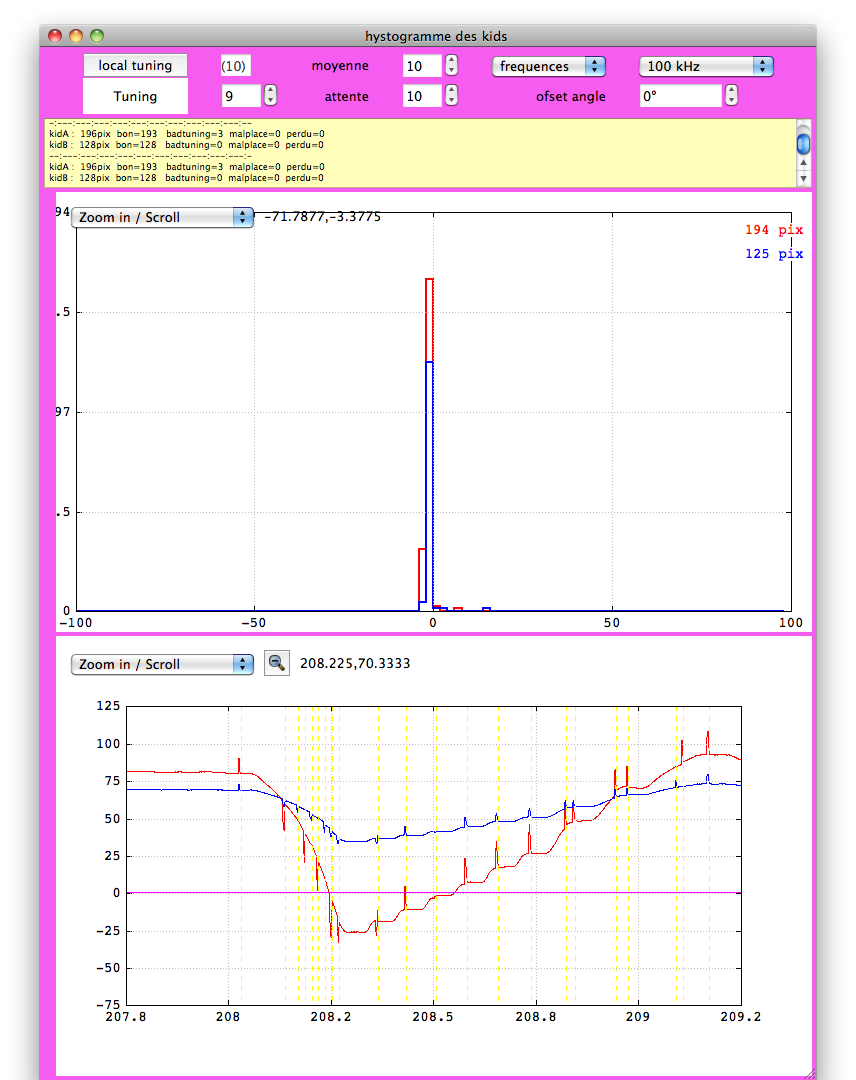
Figure. A skydip seen in the new 'hysto' tracing the dFtone. Red: 1mm; Blue:2mm. Confirms the factor 3 in response between the two arrays.
FOR THE ENTIRE 20/01/2014 SESSION NO ANTENNA DATA DUE TO SW PROBLEMS
January 21st 2014
NP SL AR at the telescope.
After discussing with Santiago: we are afraid that the minimal background is actually not the best radio alignment, indeed if the NIKA pupil is misaligned such that it sees the sky next to M2 it's possible that the background is lower than seeing only M2 (the other hypothesis we had was that the pupil misalignment sees the edge of M1 diffracting the 300K from the ground, so increase the background on the array). Too late to re-check alignment with laser and absorbers in the cabin. Only way to know now is to look at a source (Uranus) with M5 on the "best laser (alignment) position", then look at the source with M5 on the "minimal background" position and compare the beams: the stronger and narrower beam is the one with the best illumination of the telescope pupil (hoping this effect will be dominating the effect of sky noise).
Zemax simulation shows that the tilt done yesterday moves the beams position by a bit more than one detector size, and that the misalignment of the cryostat pupil with the primary may cause a significant loss of illumination (~20% on the thumb estimation from the footprint diagram, assuming laser alignment was perfect) that would create broader and fainter beams.
Observing session from 17h30 to 0h00
- 30min tests with data acquisition upgrade and tuning.
- ~2h many pointing (crosses and Lissajous) on Uranus: to understand and correct Nasmyth offsets at the 2 positions of M5, and then compare the scans. Despite a badly degrading sky we come to the conclusion that yesterday's background minimization was probably not the thing to do, since on the "best laser" position we have brighter and narrower beams than on the "minimal background" position. Alignment to be checked again with Santiago tomorrow. Note: we didn't do focus during this time because the comparison between the 2 positions of M5 is not dependent on focus, al long as there's a roughly correct beam (which was the case with ~18" at 2mm).
- Skydips while analysing and understanding pointing scans at the 2 positions of M5
At the best position for M5 and Nasmyth offset to get sources at the centre of the arrays, do focus to optimise beam => focus scans not very conclusive (sky not good, tau ~1 !). Re-use yesterday's best focus position and do several otfgeometry... tau much better on the last otfgeom.
- Uranus too low, too late for pointing session, and besides we need to continue understanding the pipeline results on pointing scans.
- Many pointings on 3c84. Try to understand results (e.g. change of rotation centre due to Nasmyth offset).

